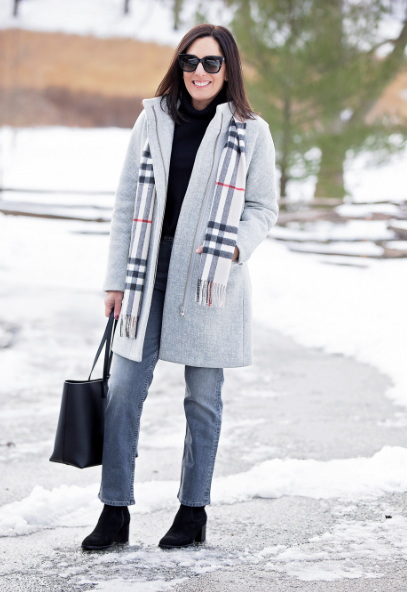Content Menu
● Understanding Chelsea Boots
>> Materials and Construction
>> Features to Look For
● How Chelsea Boots Compare to Other Winter Boots
● Practical Tips for Wearing Chelsea Boots in Snow
● Diving Deeper: The Science of Winter Footwear
>> Thermal Insulation
>> Water Resistance
>> Traction
● Choosing the Right Chelsea Boots for Snow
● Styling Tips for Wearing Chelsea Boots in Winter
● Addressing Common Concerns
● The Future of Winter Footwear
● Conclusion
● FAQ: Frequently Asked Questions About Wearing Chelsea Boots in Snow
>> 1. Are leather Chelsea boots suitable for snow?
>> 2. How do I clean Chelsea boots after wearing them in the snow?
>> 3. Can I wear suede Chelsea boots in the snow?
>> 4. What type of socks should I wear with Chelsea boots in the snow?
>> 5. Are there Chelsea boots specifically designed for snow?
● Citations:
Chelsea boots have emerged as a versatile and stylish footwear option, gaining popularity for their sleek design and ease of wear. Characterized by their ankle-high silhouette and elastic side panels, Chelsea boots are a staple in many wardrobes. However, when winter arrives, a common question arises: Can you wear Chelsea boots in the snow? The answer is nuanced, depending on several factors, including the boot's material, construction, and the weather conditions.

Understanding Chelsea Boots
Chelsea boots originated in the Victorian era and have since become a fashion mainstay, appreciated for their minimalist design and practicality. Typically made from leather or suede, these boots feature a close-fitting ankle and elastic side panels that allow for easy slip-on and removal. The versatility of Chelsea boots makes them suitable for various occasions, from casual outings to more formal events.
Materials and Construction
The suitability of Chelsea boots for snowy conditions largely depends on the materials used in their construction.
- Leather: Leather Chelsea boots are a classic choice, offering durability and a refined appearance. However, leather can be susceptible to water damage if not properly treated.
- Suede: Suede boots have a softer, textured look but are generally less water-resistant than leather. Suede requires protective sprays to withstand wet conditions.
- Rubber: Rubber Chelsea boots are an excellent option for wet and snowy weather due to their waterproof nature and added traction.
The sole of the boot also plays a crucial role. Rubber soles provide better grip on slippery surfaces compared to leather soles, making them more suitable for winter conditions. Additionally, the thickness and tread pattern of the sole can enhance traction and stability on snow and ice.
Features to Look For
When selecting Chelsea boots for winter wear, consider the following features:
- Waterproofing: Look for boots made from waterproof materials or treated with a water-resistant coating. This will help keep your feet dry and comfortable in wet conditions.
- Insulation: Insulated Chelsea boots provide extra warmth in cold weather. Options include boots with linings made of wool, fleece, or synthetic materials.
- Traction: Opt for boots with rubber soles that have a deep tread pattern for enhanced grip on slippery surfaces. Lug soles are particularly effective for navigating snow and ice.
- Ankle Support: Chelsea boots that offer good ankle support can provide added stability and reduce the risk of injury when walking on uneven or icy terrain.
- Height: Ankle-high Chelsea boots are generally preferred for snowy weather as they offer more protection against the elements compared to lower-cut styles.
How Chelsea Boots Compare to Other Winter Boots
While Chelsea boots can be suitable for winter wear, it's essential to understand how they compare to other types of winter boots.
| Feature | Chelsea Boots | Winter Boots |
| Waterproof | Can be waterproof with proper treatment or material | Typically designed to be highly waterproof |
| Insulation | Varies; some models offer insulation | Generally well-insulated for warmth |
| Traction | Depends on sole; rubber soles with good tread are preferable | Often feature aggressive tread patterns for superior grip |
| Ankle Support | Moderate ankle support | Often provide more substantial ankle and calf support |
| Style | Sleek and versatile, suitable for various occasions | More utilitarian, focused on functionality |
| Best Use | Light snow, urban environments | Heavy snow, icy conditions, outdoor activities |
Practical Tips for Wearing Chelsea Boots in Snow
If you decide to wear Chelsea boots in the snow, here are some practical tips to ensure comfort and safety:
1. Waterproof Your Boots: Apply a waterproof spray or wax to protect leather or suede boots from water damage. Reapply regularly, especially after exposure to wet conditions.
2. Wear Moisture-Wicking Socks: Choose socks made from materials like merino wool or synthetic blends to keep your feet dry and warm. Avoid cotton socks, which can trap moisture and lead to discomfort.
3. Consider Gaiters: For deeper snow, consider wearing gaiters to prevent snow from entering your boots. Gaiters are fabric coverings that extend from the ankle to the lower calf, providing an extra layer of protection.
4. Watch Your Step: Exercise caution when walking on icy or slippery surfaces. Take small, deliberate steps and avoid sudden movements that could cause you to lose your balance.
5. Clean Your Boots Regularly: After wearing your Chelsea boots in the snow, clean them to remove salt and dirt. Use a soft brush or cloth to wipe away any residue, and allow the boots to air dry away from direct heat.
6. Use Ice Grippers: For added traction on icy surfaces, consider using ice grippers or cleats that attach to the soles of your boots. These devices can significantly improve grip and reduce the risk of falls.

Diving Deeper: The Science of Winter Footwear
To truly understand the suitability of Chelsea boots in snowy conditions, it's helpful to delve into the science behind winter footwear. Factors such as thermal insulation, water resistance, and traction are crucial in ensuring comfort and safety during the colder months.
Thermal Insulation
Thermal insulation refers to the ability of a material to resist heat flow. In winter footwear, insulation helps to keep your feet warm by trapping body heat and preventing it from escaping. Different materials offer varying levels of insulation:
- Wool: Wool is a natural insulator that can absorb moisture without losing its insulating properties. It is an excellent choice for lining winter boots.
- Fleece: Fleece is a synthetic material that provides good insulation and is also lightweight and quick-drying.
- Thinsulate: Thinsulate is a synthetic insulation material made of microfibers that trap air and provide exceptional warmth without adding bulk.
The thickness of the insulation also plays a role in its effectiveness. Thicker insulation provides more warmth, but it can also make the boots bulkier and less flexible. When selecting Chelsea boots for winter wear, consider the level of insulation needed based on the typical temperatures in your area.
Water Resistance
Water resistance is the ability of a material to resist penetration by water. In winter footwear, water resistance is essential for keeping your feet dry and preventing them from becoming cold and uncomfortable. Materials like rubber and waterproof leather are highly water-resistant, while suede and untreated leather are more susceptible to water damage.
Waterproof membranes, such as Gore-Tex, can also be incorporated into the construction of winter boots to provide an extra layer of protection against moisture. These membranes are breathable, allowing moisture vapor to escape while preventing water from entering.
Traction
Traction refers to the amount of grip a sole provides on slippery surfaces. In winter conditions, traction is crucial for preventing slips and falls. Rubber soles with deep tread patterns offer the best traction on snow and ice.
The design of the tread pattern also plays a role in its effectiveness. Lug soles, which feature raised, widely spaced treads, provide excellent grip on uneven terrain. Siped soles, which have small slits cut into the treads, increase traction on icy surfaces by creating more edges for the sole to grip.
Choosing the Right Chelsea Boots for Snow
Given these considerations, how do you choose the right Chelsea boots for snowy conditions? Here's a breakdown:
1. Material Matters: Opt for Chelsea boots made from waterproof leather or rubber. These materials offer the best protection against moisture and will keep your feet dry in wet conditions.
2. Check the Sole: Look for boots with rubber soles that have a deep tread pattern. Lug soles or siped soles are ideal for providing traction on snow and ice.
3. Consider Insulation: If you live in an area with very cold winters, choose Chelsea boots with insulation made from wool, fleece, or Thinsulate. This will help keep your feet warm and comfortable in freezing temperatures.
4. Ensure a Good Fit: Make sure the boots fit properly, with enough room for thick socks. A snug fit will prevent your feet from sliding around inside the boots, which can lead to blisters and discomfort.
5. Read Reviews: Before purchasing Chelsea boots for winter wear, read reviews from other customers to get an idea of their performance in snowy conditions. Pay attention to comments about waterproofing, traction, and insulation.
Styling Tips for Wearing Chelsea Boots in Winter
Wearing Chelsea boots in winter doesn't mean sacrificing style. Here are some tips for incorporating Chelsea boots into your winter wardrobe:
- Pair with Skinny Jeans or Leggings: Chelsea boots look great with skinny jeans or leggings tucked into them. This creates a streamlined silhouette that is both stylish and practical.
- Add a Chunky Knit Sweater: A chunky knit sweater adds warmth and texture to your winter outfit. Choose a sweater in a neutral color like gray, cream, or navy to complement your Chelsea boots.
- Layer with a Parka or Puffer Jacket: A parka or puffer jacket provides excellent protection against the cold and wind. Choose a jacket that is waterproof or water-resistant to stay dry in snowy conditions.
- Accessorize with a Scarf and Hat: A scarf and hat are essential accessories for winter weather. Choose a scarf and hat in complementary colors to complete your outfit.
- Opt for Dark Colors: Dark colors like black, brown, and navy are practical choices for winter wear. They are less likely to show dirt and stains, and they can be easily paired with other items in your wardrobe.
Addressing Common Concerns
Many people have concerns about wearing Chelsea boots in snow, such as:
- Slipping: The risk of slipping on ice is a common concern. Choosing boots with good traction and using ice grippers can mitigate this risk.
- Getting Wet: Water damage is another concern, especially for leather and suede boots. Waterproofing your boots and avoiding deep puddles can help prevent water damage.
- Cold Feet: Cold feet can be a problem if your boots are not properly insulated. Choosing boots with insulation and wearing thick socks can help keep your feet warm.
- Damage to Boots: Salt and dirt can damage boots over time. Cleaning your boots regularly and using a leather conditioner can help prolong their lifespan.
By addressing these concerns and taking appropriate precautions, you can confidently wear Chelsea boots in the snow without compromising your comfort or safety.
The Future of Winter Footwear
As technology advances, the future of winter footwear is likely to bring even more innovative materials and designs. Self-heating boots, smart soles that adjust to different surfaces, and sustainable materials are just some of the possibilities. As consumers become more conscious of the environmental impact of their purchases, there will be a growing demand for eco-friendly winter footwear options.
In conclusion, Chelsea boots can be a viable option for winter wear, provided you choose the right materials, take appropriate precautions, and understand their limitations. By considering factors such as waterproofing, insulation, and traction, you can confidently wear Chelsea boots in the snow while staying comfortable and stylish.
Conclusion
Chelsea boots can be a stylish and practical choice for winter footwear, provided you select the right materials and take appropriate precautions. Opt for waterproof or water-resistant boots with good insulation and rubber soles for enhanced traction on slippery surfaces. Remember to waterproof your boots regularly, wear moisture-wicking socks, and exercise caution when walking on snow and ice. By following these tips, you can confidently wear Chelsea boots in the snow while staying comfortable and safe.

FAQ: Frequently Asked Questions About Wearing Chelsea Boots in Snow
1. Are leather Chelsea boots suitable for snow?
Leather Chelsea boots can be worn in the snow, but it's essential to protect them with a waterproofing spray or wax. Leather is susceptible to water damage, so treating it will help prevent it from becoming soaked and stained. Additionally, ensure the boots have rubber soles for better traction on slippery surfaces.
2. How do I clean Chelsea boots after wearing them in the snow?
To clean Chelsea boots after exposure to snow, use a soft brush or cloth to remove any salt or dirt residue. Wipe the boots down with a damp cloth and allow them to air dry away from direct heat. For leather boots, apply a leather conditioner to keep the material supple and prevent cracking.
3. Can I wear suede Chelsea boots in the snow?
Suede Chelsea boots can be worn in light snow, but they are not as water-resistant as leather or rubber boots. Before wearing suede boots in snowy conditions, treat them with a protective spray specifically designed for suede. This will help repel water and prevent stains.
4. What type of socks should I wear with Chelsea boots in the snow?
When wearing Chelsea boots in the snow, choose socks made from moisture-wicking materials such as merino wool or synthetic blends. These materials will help keep your feet dry and warm by wicking away sweat and moisture. Avoid cotton socks, which can trap moisture and lead to discomfort.
5. Are there Chelsea boots specifically designed for snow?
Yes, some Chelsea boots are specifically designed for snow and winter conditions. These boots typically feature waterproof materials, insulation, and rubber soles with aggressive tread patterns for enhanced traction. Look for boots labeled as "winter boots" or "snow boots" to ensure they are suitable for cold, wet weather.
Citations:
[1] https://www.reddit.com/r/malefashionadvice/comments/3ou43i/chelsea_boots_good_for_winter/
[2] https://www.youtube.com/watch?v=rR_hxr1LwoQ
[3] https://stylewhirl.com/can-we-wear-chelsea-boots-in-snow/
[4] https://www.phabhu.com/blogs/phabhu/advantage-wearing-chelsea-boots
[5] https://pixabay.com/videos/search/chelsea%20boots/
[6] https://stylewhirl.com/are-chelsea-boots-versatile/
[7] https://www.zoomshoes.in/blogs/news/winter-ready-why-every-man-needs-chelsea-boots-this-season
[8] https://www.shutterstock.com/video/search/chelsea-boot

















